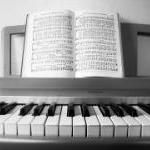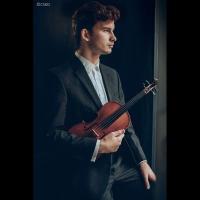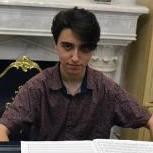Search the Community
Showing results for tags 'piano', 'sonata', 'solo' or 'alevel'.
-
Dear all, This is a piece I wrote back then, in 2021, for a call-for-score competition of a piano performing competition. This is meant to be a part of the repretoire performers can choose from for their programme. Unfortunately, the competition is heavily impacted by the pendemic and I cannot listen to the live/ streamed performance of this peice. Here is my original note for this work. "This toccata is the second work in the composer’s recent piano series which explore polyrhythmic motif development. The piece starts with a simple, tranquil theme and it evolves into a fast quasi-fugue. Later, the passionate 3-against-5 passage enters with contrasts to the first motif. After the appearance of both motives, variations follow and direct the development for the rest of the toccata. " HoYin
-
Hey everyone, this is a project I did for my Theory: Intro to Harmony class. We started with just a chord progression, then added texture and a melody. I'd love to hear any feedback, and if anyone thinks of a title, please let me know
- 12 replies
-
- 1
-

-
- jazz arranging
- clarinet
-
(and 2 more)
Tagged with:
-
Uno de estos días... One of these days. A simple piano piece, with its twists .... That's the one of my dogs (calle Happy) is.
-
Hi everyone! I have previously posted the second movement of my second Piano Sonata here: Now I am posting the first movement of the work! Here are the pdf and the mp3: Piano Sonata no.2 in A-flat Major First Movement.pdf Piano Sonata no.2 First Movement.mp3 I've also included the YT video here: I didn't introduce the inspiration of this sonata in my post in the second movement to have it here. Piano Sonata no.2 in A-flat major (2015) is composed right after the completion of the first Piano Sonata. It's the quickest composition at all since I had only used 3 weeks to finish the first draft of it.(It's very quick in my standard since well, I can use 6 years to compose my clarinet quintet...) I adopt a freer approach here to contrast with the first Piano Sonata which is very cohesive. Here I really just write what I want and this may result in less tight structure of the overall work. But it's definitely more akin to my emotion and feeling here! I only use 2 days to finish the first draft of this movement in 6-7 May 2015. It begins in a Schubertian manner and several episodes in it, stimulating the later movements and transformed into a Beethovanian one, akin to his op.110 in the same key. I really love how serene this movement begins and motivational at the end! The overall form of the piece can be considered as follow: B.1-32 (00:00-01:18): Main theme, serene and Schubertian in A flat major. Backbone of the piece B.33-81 (01:19-03:16): Secondary theme begins in f minor but confirms the A flat major. Inspire 2nd movement. B.82-98 (03:17-04:00): Doloroso in C sharp minor my favourite key! End of the first part. Inspire 4th movement. B.99-135 (04:01-05:00): Struggling to create power in a Beethovanian manner. B.136-159 (05:01-05:42) Reprise of the opening theme but in Beethovaian manner especially with influence of his op.110 in the same key!!(My favourite Beethovan Sonata too!) B.160-183 (05:43-06:25): Crystallization of the opening theme? Inspire fifth movement esp. its coda. B.184-194 (06:26-06:57): Affirmation of the opening theme though weakened at the end to pave the way to the denial in the second movement. I am very happy to have composed this sonata as I feel like I am free flowing during the process. I also love how the emotions flow within it whether it's serene, hopeful, tragic, agitated or transfigured. I just ignore all those parallel 5ths and 8ves since the sound is great. It may suffer from the lack of coherence though especially in the first movement, but it helps inspire the later movements with the episodes so I am very grateful I make this! The recoding is made in 18/03/2023. There are two obvious slips in 04:06 and 04:12. But the rest of the recording is quite beautiful and faithful to the music so I retain it. Hope you enjoy this as well and thanks for listening!!! P.S The post for the third movement is attached here: The post for the fourth movement is attached here: Henry
-
Since Covid made singing in groups so unsafe, choirs have taken a real hit to their membership, and many are still smaller than they were before the pandemic. I wrote this piece to be performable by a small group. The range of the baritone part should be manageable by either tenors or basses, since they are generally the smallest sections in a choir, to help with balance issues. The baritone part does divide a bit for the sake of interest and to give any bass 2s a break from their high range, but as the piano and other parts are generally covering those splits, they can be done away with if a group only has a single male voice, or a conductor chooses to put all their tenors and basses on a single line to improve balance against larger soprano and alto sections. The ranges of the soprano and alto parts are also moderate enough that an alto 1 could sing soprano or a soprano 2 could sing alto in the case of unbalanced sections. I've mainly limited dynamics to mp and mf, since smaller groups are more likely to have blending and balance issues at very loud dynamics or sound timid at softer ones. I'd love to know your thoughts, particularly pianists! (I'm not a pianist). Does anything seem particularly awkward, or should be written for the other hand? Would the thorny accidentals at measure 63-64 be easier to sight-read at speed if I used the Cb and Bbb enharmonic equivalents, so those righthand notes were in paired thirds going up and down the scale? Thank you for your thoughts! Revelation 21 KJV 1 And I saw a new heaven and a new earth: for the first heaven and the first earth were passed away; and there was no more sea. 4 And God shall wipe away all tears from their eyes; and there shall be no more death, neither sorrow, nor crying, neither shall there be any more pain: for the former things are passed away. 5 And he that sat upon the throne said, Behold, I make all things new. And he said unto me, Write: for these words are true and faithful.
- 5 replies
-
- 1
-

-
- revelation 21:1-5
- environmental destruction
-
(and 7 more)
Tagged with:
-
Not sure what game soundtrack this would fit, but it sounds like it could maybe be music for a loading screen on Animal Crossing or something.
-
Hi everybody, Going over some unfinished ideas, I came across this fragment. It has some unbalanced parts... But do you think I should retake it? I have made progress with my rhetoric figures, and soon the first entries will be ready... I thin I can use them in any style and I need some fresh different music (than the galant style I was studying).
-
Hi all, wanted to share a piece I have written very recently, and get your feedback, Enjoy the listening! Julien PS: scores (and midi) available on https://imslp.org/wiki/Tableau_No.3_(Piaser%2C_Julien)
-
Hey guys. First post woo! This is for a class I'm taking (studying composition right now) and kind of just wanted general "first opinions" on this piece. Any feedback is good feedback, thanks 😄 Kinda lame, but this is very influenced by Mario Galaxy (specifically buoy base) lol it's a great soundtrack we can't deny it
-
This is my "Soliloquy for Clarinet No. 21". Here is the link to my previous soliloquy for clarinet, composed in March 2020: https://www.youngcomposers.com/t39457/soliloquy-for-clarinet-no-20/
-
The Ballade in E-flat minor was written in 2021. Though it is written for solo piano, I had intended to write it for piano and orchestra, and may make a version of it for this ensemble in the future. The piece is about 8 minutes long. I hope you all enjoy it 🙂
-
Hi! I'm a senior in high school who plays piano and organ. Would any composers be interested in composing the finale of a four-movement piece based on a Ukrainian folk tune? My channel and I have been working on our "Symphonic Variations on a Ukrainian Folk Tune" for nearly 11 months. Without being overly political (political works of art tend to get dated quickly), our piece is a gesture in support of the Ukrainians and anyone else working for peace. This would admittedly be a tricky project. 🥴 1. The work would incorporate the folk tune "Long Live Free Ukraine": https://musescore.com/user/40554345/scores/7785305 , which is featured in the other three movements. 2. Also, the finale would need to incorporate ideas from the rest of the piece. This would help provide unity. An example would be the Ukrainian national anthem, one of the main themes of the opening Allegro Moderato. 3. It would be scored for piano, organ, a small SATB choir, and hopefully percussion. 4. The rest of the piece is surprisingly lengthy, so it would hopefully be at least 20 minutes in length to balance. (I do apologize if that seems like a lot.) 5. The work is not a piece of chamber music. We're calling for organ and piano instead of orchestra because that's much simpler. The choral finale would have the "feel" of a large-scale symphonic finale (think Myaskovsky or even Beethoven or Mahler 😳), successfully resolving all the tensions of the previous movements. Think big! Be a "visionary." Imagine that you could somehow resolve all the conflicts in the world through a single piece of music. 6. In addition, any potential composers would need to look over a current draft of the finale by the composer of the first movement. They'd incorporate whatever ideas they might want from the sketch in their composition. If they don't want to include anything from the draft, they definitely don't need to. (The composer and I thought that the sketch was unsatisfactory, but that it did contain a few decent ideas.) 7. I'm still working out what exactly what the choral text would be. 8. I'd be willing to pay up to five hundred dollars through PayPal. 9. The current structure of the work is I. Allegro Moderato (E minor, 13 minutes) [complete] II. Passacaglia (B-flat minor) [still in progress] III. Variations (E minor, 20+ minutes) [essentially complete] IV. Finale (E minor - E major, 20+ minutes) [unfinished] 10. Finally, I've recorded six of the third movement's variations and uploaded them to our YouTube channel, Classicore. I'll finish recording the piano and organ parts within the next few months, and other musicians I know will record the choral and percussion parts. We'll upload the finished project to the channel. https://www.youtube.com/watch?v=u5azSx8mwns&list=PLxww_oRF72uwahVSvXanfLYYHZilGYyMf This is admittedly a difficult project, but I would be incredibly grateful to find a composer to work with! If you're interested, definitely reach out! I'd appreciate it. Sincerely, Dominic Fiacco
-
Hi, i'm new in this forum and i don't understand how it works really well haha, also, i'm not an english native speaker so don't mind any grammar error. Those preludes are my firsts compos itions. The second prelude's interpretation is really awful lmao, both were made by a computer software.
-
hello everyone, this is my new piece, hope you like it! the video: 【微分音钢琴】作品5之7 无标题_哔哩哔哩_bilibili
- 3 replies
-
- 2
-

-
- sonata
- microtonal
-
(and 5 more)
Tagged with:
-
Hello! I'm very new to this platform, but I am a young composer who thought I might find some good feedback and interactions here. Here is my first submission; a short little 'aria' for organ that I have been working on for the last couple of days. It is perhaps more conventional, harmonically and otherwise, than some of my other works. I took direct inspiration from Noel Rawsthorne's 'Aria' (which I am currently learning myself) in many features of the piece, particularly the form and structure. A computer playback version will have to do for now, I'm afraid, but I will try and record this myself when I go in to my local church for some organ practice this week. I hope my registration instructions and our imaginations will be able to overcome the registration of this synthesized version, particularly in the computer's conservative interpretation of ritardandos. Any feedback or suggestions are very welcome!
-
A little slightly more contemporary piece for solo flute that I have been working on for a while. In the first movement, I make use of a ‘filtering’ technique to develop the material; I began the piece by writing out a progression of modes, a few notes altered by a few semitones each time, which I work through to gradually modulate (with some exceptions!). I went for senza misura for this movement as I was looking for a more contemplative and tranquil tone, hence the title 'Penseroso', and to give performers as much space and creative opportunity as possible, which I something I always strive for. I contrast this with the virtuosic and frantic nature of the second movement ‘Scherzando’. I began by planning a sequence time signatures to be repeated, in such a pattern that an audience would be oblivious, to convey this freneticism. I develop this sequence; I designed an exchange in length within the piece of the high, loud, staccato sections and low, softer legato sections, in which the staccato sections gradually grow shorter as the legato sections grow longer, until roughly halfway, when the staccato sections lengthen again, and the legato sections shorten (I hope I worded that clearly enough!). I am particularly pleased with the sudden shock ending of this movement, designed in contrast to the soft a niente’ of the first movement. I managed to persuade a flautist friend to record this for me, and they have done an excellent job. I hope you enjoy the sounds of a real instrument, unlike last time! Any feedback and suggestions much appreciated.
-
1. Adagio Molto Moto: This movement explores the relationship between our mechanical world and our own expressiveness as a species. 2. Contemplatively Pious: This movement is a self-meditation for the listener. An opportunity to breath after the soundmass of the first movement and consider the world within which we live. 3. Savagely, Allegro Vivace: This movement is a savage, almost warlike movement that finishes the work.
-
I really put my soul into this one. Do not be shy to give me constructive suggestions. I really appreciate them 🙂
-
After a long hiatus, I started writing a little piano sonata as a gift for a dear friend. The piece is partly modeled after some sonatas Haydn wrote in his early years, presumable for his students. I wanted to write something that I can play myself with my rather limited skills, so it's not too complicated. Still, the attached MP3s are computer-generated. Also, I have yet to add the dynamics I use to the score. All three movements have a rising triad as characteristic motive, the slow second movement in a more drawn-out fort than the other ones. The Adagio features a strong walking bass line which is rather atypical for the overall style, but gives the movement a strong momentum. The Menuetto is rather simple to increase the contrast with the Trio that features suspensions etc., and should provide a joyous end.
-
Hello, My brand new piece of music. What do you think?
-
As a violinist, I've always felt today's musical landscape is missing something with the general absence of any modern violinist-composers along the lines of Paganini, Wieniawski, Sarasate, and so on to contribute new and exciting pieces to the repertoire. But since I'm both a violinist and a composer, I figure I might as well throw my hat in the ring and try to fix that. I've written four pieces by now, though I'd only ever performed two -- until recently, when I got to premiere the third. I composed this piece back in 2020, shortly before the entire world shut down. But recently I finally found a good opportunity to perform it, so I gave the "world premiere" on November 9, 2022. Unfortunately it was not recorded except on a phone at the back of the hall, and the massive echo made it sound pretty muddy. So I got a recording session in today in order to get higher-quality audio. Here's the end result: https://www.youtube.com/watch?v=WghXNdOc-VY The indication "harm." in the part is not me being too lazy to make diamond noteheads -- it is the notation used by violinist Roman Kim (one of my biggest inspirations and another torch-bearer of modern violin composition) to indicate the use of the forced harmonics technique he invented. It sounds one octave higher than written, is fingered exactly as written, and always lasts until the following "ord." mark. They appear at timestamps 2:15 and 3:56. While exceptionally challenging to master, they unlock some sounds that would otherwise be impossible to produce, so I think it would be interesting if the technique could become more widely learnt and incorporated into more modern violin writing.
-
December 24th 1914, Wordl War I. Near Ypres (Belgium), the German army began decorating the trenches and sang Silent Night in German (Stille Nacht). Soon the English army answered singing it in English. After a silence, they began to shout and congratulate one another. The Christmas truce took place, and they shared gifts and hugs. There were no gunshots that night. The fallen soldiers were remembered in an improvised ceremony, reading Psalm 23. I friend of mine and I wrote this little piece for two pianos a few years ago. We live very far from each other and we did it "online". These days of war brought this work to my mind.









.thumb.jpg.e5f26b712b4f9622f521b10d8a53c6d6.jpg)





